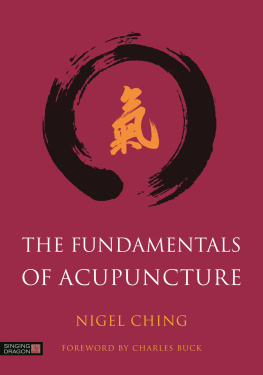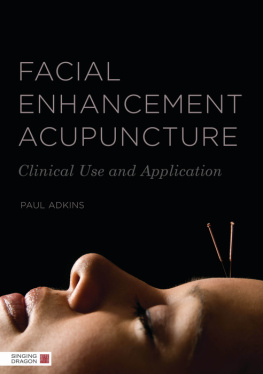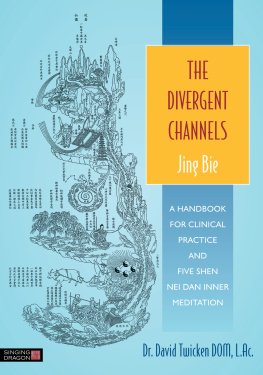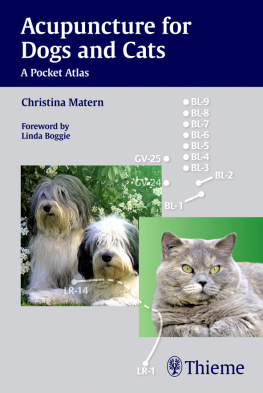Nigel Ching - The Fundamentals of Acupuncture
Here you can read online Nigel Ching - The Fundamentals of Acupuncture full text of the book (entire story) in english for free. Download pdf and epub, get meaning, cover and reviews about this ebook. year: 2016, publisher: Singing Dragon, genre: Religion. Description of the work, (preface) as well as reviews are available. Best literature library LitArk.com created for fans of good reading and offers a wide selection of genres:
Romance novel
Science fiction
Adventure
Detective
Science
History
Home and family
Prose
Art
Politics
Computer
Non-fiction
Religion
Business
Children
Humor
Choose a favorite category and find really read worthwhile books. Enjoy immersion in the world of imagination, feel the emotions of the characters or learn something new for yourself, make an fascinating discovery.
- Book:The Fundamentals of Acupuncture
- Author:
- Publisher:Singing Dragon
- Genre:
- Year:2016
- Rating:4 / 5
- Favourites:Add to favourites
- Your mark:
- 80
- 1
- 2
- 3
- 4
- 5
The Fundamentals of Acupuncture: summary, description and annotation
We offer to read an annotation, description, summary or preface (depends on what the author of the book "The Fundamentals of Acupuncture" wrote himself). If you haven't found the necessary information about the book — write in the comments, we will try to find it.
The Fundamentals of Acupuncture — read online for free the complete book (whole text) full work
Below is the text of the book, divided by pages. System saving the place of the last page read, allows you to conveniently read the book "The Fundamentals of Acupuncture" online for free, without having to search again every time where you left off. Put a bookmark, and you can go to the page where you finished reading at any time.
Font size:
Interval:
Bookmark:

The Fundamentals of
ACUPUNCTURE

NIGEL CHING
Foreword by Charles Buck

LONDON AND PHILADELPHIA
CONTENTS
FOREWORD
As an educator in acupuncture and Chinese medicine it is tempting to enjoy the reflected glory of past students achievements. Seeking to resist such empty vanity I instead applaud their accomplishments in the belief that credit properly belongs to those who do the work rather than their teachers. Nevertheless, some pleasure remains in having the opportunity to proudly introduce this textbook and its author Nigel Tonto Ching to the English-speaking acupuncture and Chinese medicine community.
I came to know Nigel in 2000 when he began the three-year training in Chinese herbal medicine on which I was a lead tutor. It quickly became clear that he wished to get his moneys worth from this course, as evidenced by the fact that all the assignments I marked of his were close to flawless. Later I came to discover a person who was determined, not only to immerse himself deeply into the wisdom that acupuncture and Chinese medicine offers, but to interpret and share that wisdom with others. Nigel has published three major textbooks in Danish, texts that have become established as standard student resources. His skills as a communicator and dedication to his profession have helped him become a prominent educator in Nordic countries and more widely across the European Union.
What is presented so succinctly in this text is the current standard model of acupuncture practice, an understanding that is shared by perhaps a million practitioners worldwide. This is a lucid account of the current interpretation of the extraordinarily diverse scholarly medical tradition of China, a medical system whose literature base extends back almost 2500 years and whose historical literature base runs to many of thousands of volumes. This text provides the foundation that informs modern practice. It provides coherence to a complex historical tradition and sets out the dominant interpretation that is the basis of most acupuncture practice and research worldwide. Before this interpretation was made available to practitioners and students in the West, our learning resources were a confusing mix of fact, fantasy and misapprehension a mish-mash of Chinese whispers.
In the past, limited scholarship combined with the tendency to romantic orientalism meant that acupuncture study was a frustrating process for those who sought to practice this medicine in a plain, effective and authentic manner. With insufficient information and understanding we coloured this medicine with our own fantasies about what we would expect this medicine to be about, an instance of the human tendency to see things that are other in terms of things that are already familiar to us (a trait that was summed up in just six words by the playwright and intellectual Eugene Ionescu as the French for London is Paris!). Fortunately, less than four decades ago, Chinas new standard model for this medicine was delivered to us by scholar-pioneers such as Dan Bensky, John OConnor, Ted Kaptchuk, Giovanni Macciocia and others. These were exceptional people who had taken the trouble to learn the Chinese language and who had devoted long periods to study extensively in China at a time when travel and life there was difficult. What they brought was a breath of fresh qi for those of us who had previously wallowed in the obscure hinterlands between Chinese philosophy, metaphysics and medicine. The more pragmatic style they brought was appealing because it was congruent with the understanding that we had already learned from exposure to ancient classics such as the Yijing ( Classic of Change ) and Huangdi Nejing ( Yellow Emperors Inner Classic ), but the teachings included fewer confusing distractions. The subject was now laid out for us in a coherent, understandable and down-to-earth way. Halleluja! This is the interpretation of Chinas acupuncture tradition that Nigel offers you here.
In the decades since the introduction of this style of acupuncture practice our profession has continued to mature significantly we benefit from improved translation resources and ever-greater levels of scholarship. During the same period the bamboo curtain almost completely lifted and we gained more direct access to Chinas classical medical corpus as well as to the generosity of many high-level scholar-practitioners from China. Alongside this, we also gained clearer perspectives on the manner in which this venerable medical tradition was re-interpreted and re-packaged to meet the needs of Chinas health service in the communist era and to match the political imperatives that dominated the 1960s and 70s. We came to appreciate, too, that ownership of this medicine is not entirely Chinese, that diverse interpretations and styles of practice had emerged over long periods in other East Asian countries, notably Japan, Korea and Vietnam. These countries added their own layers of scholarly interpretation for well over one thousand years and that the styles they have evolved also deserve our attention and respect.
In the 1950s, having made the political decision to include traditional medicine in their healthcare provision, Chinese authorities surveyed the mind-boggling diversity of medically related beliefs and practices that had been acquired over the two previous millennia; essentially an unwieldy mix of sense, half-sense and nonsense, superstition and rationality. Much of what the various medical traditions contained was unworkable in the modern world and so decisions had to be made about what would be included in the medical curriculum and what would be excluded. They will have known, for instance, that the Imperial Medical College of the Song dynasty (9601278) included extensive study of chanting as a therapeutic modality. It is possible that chanting delivered some useful therapeutic value to people at that time but it did not appear well-matched to the clinical needs in the forward-looking communist world of the 1960s.
Medical practices connect intimately with the cultural beliefs and norms of their time and many of those from old China were no longer congruent with those of today. Belief in the influence of ancestor spirits, astrological notions and the ancient medical practice of writing therapeutic Chinese characters on paper and asking patients to burn this and then swallow the ash were part of the healthcare tradition. The authorities chose to exclude such ideas from the modern scope of practice and so, with this in mind, panels of doctors in the 1950s and 60s were tasked with surveying the formal written tradition. The intention was to reassemble the tradition into a compact practical medicine that was teachable, examinable and a practical means for providing healthcare to millions. As neophytes navigating through the maze of half-understood classical ideas, it was this coherent modern style that my student generation welcomed near the beginning of our journey into this medicine.
Later, as we ourselves gained direct access to the historical literature, we began to understand the way that this sanitisation process had operated and we came to appreciate that this style was only a rough approximation of the tradition. We noticed that thinkers in China had grafted ideas that more properly belonged to the herbal medicine practice onto acupuncture theory, such as the idea of formalised acupoint actions (e.g. Tai xi Kidney 3 Nourishes Kidney Yin ) . Whilst not, of itself, an unhelpful innovation, we realised that this was not quite the way things were presented historically. We discovered, too, that some interesting branches of the acupuncture tree had been unceremoniously lopped off in the quest for rationality. The spiritual and emotional content of the tradition had been downplayed and simplified. Now we can see that this was understandable because, after all, communism by definition provides a guarantee of happiness for all. Why would there be any need to include discussions of depression? Further, wishing to see a closer match with modern biomedicine meant that some basic traditional aspects of theory had to be downplayed chronobiology (the biology of time) and the wu xing (five element) model of change, for example.
Next pageFont size:
Interval:
Bookmark:
Similar books «The Fundamentals of Acupuncture»
Look at similar books to The Fundamentals of Acupuncture. We have selected literature similar in name and meaning in the hope of providing readers with more options to find new, interesting, not yet read works.
Discussion, reviews of the book The Fundamentals of Acupuncture and just readers' own opinions. Leave your comments, write what you think about the work, its meaning or the main characters. Specify what exactly you liked and what you didn't like, and why you think so.

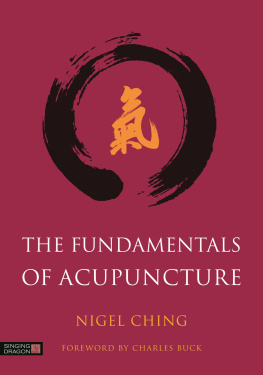
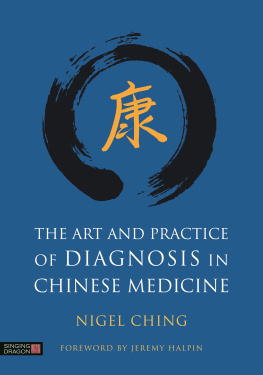

![John Urbanski D.C. - Acupuncture Meridian Point Locations Atlas [fixed Toc and Links]](/uploads/posts/book/281557/thumbs/john-urbanski-d-c-acupuncture-meridian-point.jpg)
